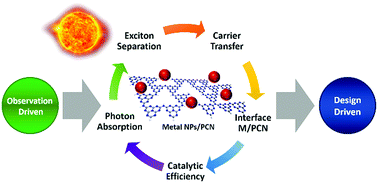当前位置:
X-MOL 学术
›
Chem. Soc. Rev.
›
论文详情
Our official English website, www.x-mol.net, welcomes your
feedback! (Note: you will need to create a separate account there.)
Carbon nitrides and metal nanoparticles: from controlled synthesis to design principles for improved photocatalysis
Chemical Society Reviews ( IF 40.4 ) Pub Date : 2018-09-20 00:00:00 , DOI: 10.1039/c8cs00479j Ivo F. Teixeira 1, 2, 3, 4, 5 , Eduardo C. M. Barbosa 1, 2, 3, 4, 5 , Shik Chi Edman Tsang 6, 7, 8, 9, 10 , Pedro H. C. Camargo 1, 2, 3, 4, 5
Chemical Society Reviews ( IF 40.4 ) Pub Date : 2018-09-20 00:00:00 , DOI: 10.1039/c8cs00479j Ivo F. Teixeira 1, 2, 3, 4, 5 , Eduardo C. M. Barbosa 1, 2, 3, 4, 5 , Shik Chi Edman Tsang 6, 7, 8, 9, 10 , Pedro H. C. Camargo 1, 2, 3, 4, 5
Affiliation

|
The use of sunlight to drive chemical reactions via photocatalysis is of paramount importance towards a sustainable future. Among several photocatalysts, earth-abundant polymeric carbon nitride (PCN, often wrongly named g-C3N4) has emerged as an attractive candidate due to its ability to absorb light efficiently in the visible and near-infrared ranges, chemical stability, non-toxicity, straightforward synthesis, and versatility as a platform for constructing hybrid materials. Especially, hybrids with metal nanoparticles offer the unique possibility of combining the catalytic, electronic, and optical properties of metal nanoparticles with PCN. Here, we provide a comprehensive overview of PCN materials and their hybrids, emphasizing heterostructures with metal nanoparticles. We focus on recent advances encompassing synthetic strategies, design principles, photocatalytic applications, and charge-transfer mechanisms. We also discuss how the localized surface plasmon resonance (LSPR) effect of some noble metals NPs (e.g. Au, Ag, and Cu), bimetallic compositions, and even non-noble metals NPs (e.g., Bi) synergistically contribute with PCN in light-driven transformations. Finally, we provide a perspective on the field, in which the understanding of the enhancement mechanisms combined with truly controlled synthesis can act as a powerful tool to the establishment of the design principles needed to take the field of photocatalysis with PCN to a new level, where the desired properties and performances can be planned in advance, and the target material synthesized accordingly.
中文翻译:

碳氮化物和金属纳米颗粒:从受控合成到改进光催化的设计原理
使用太阳光通过光催化来驱动化学反应对于实现可持续的未来至关重要。在几种光催化剂中,富含地球的聚合氮化碳(PCN,通常错误地命名为gC 3 N 4由于具有在可见光和近红外范围内有效吸收光的能力,化学稳定性,无毒,简单易懂的合成和多功能性(作为构建杂化材料的平台),它已成为有吸引力的候选物。特别是,与金属纳米粒子的杂化体提供了将金属纳米粒子与PCN结合在一起的独特催化能力,电子和光学特性。在这里,我们提供PCN材料及其混合材料的全面概述,强调金属纳米颗粒的异质结构。我们专注于包括合成策略,设计原理,光催化应用和电荷转移机制在内的最新进展。我们还将讨论一些贵金属纳米粒子(例如,Au,Ag和Cu),双金属成分,甚至非贵金属NP(例如Bi)在光驱动转换中与PCN协同作用。最后,我们提供了一个有关该领域的观点,其中对增强机制与真正受控合成相结合的理解可以作为建立将PCN光催化领域提高到新水平所需的设计原理的有力工具,可以预先计划所需的性能和性能,并相应地合成目标材料。
更新日期:2018-09-20
中文翻译:

碳氮化物和金属纳米颗粒:从受控合成到改进光催化的设计原理
使用太阳光通过光催化来驱动化学反应对于实现可持续的未来至关重要。在几种光催化剂中,富含地球的聚合氮化碳(PCN,通常错误地命名为gC 3 N 4由于具有在可见光和近红外范围内有效吸收光的能力,化学稳定性,无毒,简单易懂的合成和多功能性(作为构建杂化材料的平台),它已成为有吸引力的候选物。特别是,与金属纳米粒子的杂化体提供了将金属纳米粒子与PCN结合在一起的独特催化能力,电子和光学特性。在这里,我们提供PCN材料及其混合材料的全面概述,强调金属纳米颗粒的异质结构。我们专注于包括合成策略,设计原理,光催化应用和电荷转移机制在内的最新进展。我们还将讨论一些贵金属纳米粒子(例如,Au,Ag和Cu),双金属成分,甚至非贵金属NP(例如Bi)在光驱动转换中与PCN协同作用。最后,我们提供了一个有关该领域的观点,其中对增强机制与真正受控合成相结合的理解可以作为建立将PCN光催化领域提高到新水平所需的设计原理的有力工具,可以预先计划所需的性能和性能,并相应地合成目标材料。











































 京公网安备 11010802027423号
京公网安备 11010802027423号